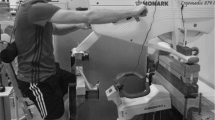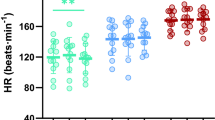Abstract
The primary purpose of this study was to determine if the aerobic demand for production of specified power outputs is altered by distribution of work between the arms and legs compared with when all the work is performed by the legs. Because of the important exercise training implications, a secondary purpose of this study was to determine if the exercising muscle mass affects the cardiorespiratory demands at specified rating of perceived exertion (RPE) levels and blood lactate concentrations. Nine healthy adults completed leg cycling and combined arm and leg exercise on an Airdyne using a discontinuous protocol. Repeated measures ANOVA revealed that oxygen uptake for the combined arm and leg exercise averaged 0.04 l·min−1 greater (p<0.05) than for leg cycling at the same external power outputs. However, RPE levels at specified power outputs were lower (p<0.05) with combined arm and leg exercise than leg cycling. At specified RPE levels and blood lactate concentrations, oxygen uptake and heart rate values were higher (p<0.05) for combined arm and leg exercise than leg cycling. From these findings we conclude that: (1) the addition of arm exercise to leg cycling results in a reduction in RPE, but a minimal increase in oxygen consumption to perform a given power output, and (2) if training intensity is established by RPE or blood lactate concentration, use of a muscle mass larger than that used in leg cycling should allow a greater cardiorespiratory training effect.
Similar content being viewed by others
References
American College of Sports Medicine (1991) Guidelines for exercise testing and prescription. In: Guidelines for exercise test administration. Lea and Febiger, Philadelphia, pp 71
Bevegard S, Freyschuss U, Strandell T (1966) Circulatory adaptation to arm and leg exercise in supine and sitting position. J Appl Physiol 21: 37–46
Borg G (1970) Perceived exertion as an indicator of somatic stress. Scand J Rehabil Med 2–3: 92–98
Butts NK, Knox KM, Foley TS (1995) Energy costs of walking on a dual-action treadmill in men and women. Med Sci Sports Exerc 27: 121–125
Ekblom B, Goldbarg AN (1971) The influence of physical training and other factors on the subjective rating of perceived exertion. Acta Physiol Scand 83: 399–406
Glaser RM, Sawka MN, Young RE, Suryaprasad AG (1980) Applied physiology for wheelchair design. J Appl Physiol Respir Environ Exerc Physiol 48: 41–44
Hagerman FC, Lawrence RA, Mansfield MC (1988) A comparison of energy expenditure during rowing and cycling ergometry. Med Sci Sports Exerc 20: 479–488
Henritze J, Weltman A, Schurrer RL, Barlow K (1985) Effects of training at and above the lactate threshold on the lactate threshold and maximal oxygen uptake. Eur J Appl Physiol 54: 84–88
Hetzler RK, Seip RL, Boutcher SH, Pierce E, Snead D, Weltman A (1991) Effect of exercise modality on ratings of perceived exertion at various lactate concentrations. Med Sci Sports Exerc 23: 88–92
Higgs SL, Robertson LA (1981) Cyclic variations in perceived exertion and physical work capacity in females. Can J Appl Sports Sci 6: 191–196
Hoffman MD, Clifford PS, Foley PJ, Brice AG (1990) Physiological responses to different roller skiing techniques. Med Sci Sports Exerc 22: 391–396.
Hoffman MD, Jones GM, Bota B, Mandli M, Clifford PS (1992) In-line skating: physiological responses and comparison with roller skiing. Int J Sports Med 13: 137–144
Hoffman MD, Clifford PS, Watts PB et al. (1994) Physiological comparison of uphill roller skiing: diagonal stride versus double pole. Med Sci Sports Exerc 26: 1284–1289
Moldover JR, Downey JA (1983) Cardiac responses to exercise: comparison of three ergometers. Arch Phys Med Rehabil 64: 155–159.
Reybrouck T, Heigenhauser GF, Faulkner JA (1975) Limitations to maximum oxygen uptake in arm, leg, and combined arm-leg ergometry. J Appl Physiol 38: 774–779
Sargeant AJ, Davies CTM (1973) Perceived exertion during rhythmic exercise involving different muscle masses. J Hum Ergol 2: 3–11
Sjodin B, Jacobs I, Svendenhag J (1982) Changes in onset of blood lactate accumulation (OBLA) and muscle enzymes after training at OBLA. Eur J Appl Physiol 49: 45–47
Skinner JS, Hutsler R, Bergsteinova V, Buskirk ER (1973) Perception of effort during different types of exercise and under different environmental conditions. Med Sci Sports 5: 110–115
Stenberg J, Astrand P-O, Ekblom B, Royce J Saltin B (1967) Hemodynamic response to work with different muscle groups, sitting and supine. J Appl Physiol 22: 61–70
Taguchi S, Horvath SM (1987) Metabolic responses to light arm and leg exercise when sitting Eur J Appl Physiol 56: 53–57
Toner MM, Sawka MN, Levine L, Pandolf KB (1983) Cardiorespiratory responses to exercise distributed between the upper and lower body. J Appl Physiol Respir Environ Exerc Physiol 54: 1403–1407
Vokac Z, Bell H, Bautz-Holter E, Rodahl K (1975) Oxygen uptake/heart rate relationship in leg and arm exercise, sitting and standing. J Appl Physiol 39: 54–59
Yoshida T, Suda Y, Takeuchi N (1982) Endurance training regimen based upon arterial blood lactate: effects on anaerobic threshold. Eur J Appl Physiol 49: 223–230
Zeni AI, Hoffman MD, Clifford PS (1996a) Relationships among heart rate, lactate concentration, and perceived effort for different types of rhythmic exercise in females. Arch Phys Med Rehabil 77: 237–241
Zeni AI, Hoffman MD, Clifford PS (1996b) Energy expenditure with indoor exercise machines. J Am Med Assoc 275: 1424–1427
Author information
Authors and Affiliations
Rights and permissions
About this article
Cite this article
Hoffman, M.D., Kassay, K.M., Zeni, A.I. et al. Does the amount of exercising muscle alter the aerobic demand of dynamic exercise?. Europ. J. Appl. Physiol. 74, 541–547 (1996). https://doi.org/10.1007/BF02376770
Accepted:
Issue Date:
DOI: https://doi.org/10.1007/BF02376770




